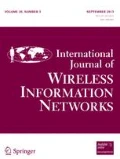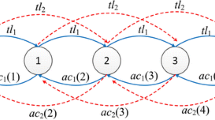Abstract
In order to provide mobile worldwidecommunication services, cellular systems can be based ona multilayered, multisized cells architecturecharacterized by the use of different technologies.Satellites can cover lightly populated areas, as well asthose areas where other means cannot be used (like thesea); fixed base stations, with different transmissionpowers and thus different cell sizes, can cover relatively highly populated areas. As a result,a given area could simultaneously be served by more thanone Base Station, and the structure of such a systemmust be carefully designed. A Hierarchical Architecture(HA) scheme is a possible solution. HA is based on amultilevel cell configuration: microcells (or evenindoor picocells) cover more densely populated areas andare given the majority of the traffic load as they are able to operate with very highcapacity, while overlaying macrocells (or satellitarcells) provide a group of overflow channels.Occasionally, when microcells are not able to satisfychannel requests, the overflow channels are consumed.HA schemes are divided in two categories: ReversibleHierarchical (RH) and Non Reversible (NRH). Thedifference is given by the handover directions between cells allowed. In a RH handover, attemptsbetween macrocells and microcells occur in bothdirections. This paper compares RH and NRH schemes bymeans of an analytical model based on birth-deathprocesses. The main performance indexes and the controloverhead are shown.
Similar content being viewed by others
REFERENCES
C. Vinodrai Sarnecki, A. Javed, P. O’Kelly, and K. Dick, Microcell design principles, IEEE Communications Magazine, 1993, pp. 76–82.
E. Nakano Murata, Enhancing the performance of mobile communication systems, Proc. IEEE Int. Conf. on Universal Personal Communications ICUPC ’93, Ottawa, Canada, 1993, pp. 732–736.
J. Whitehead Steele and W. C. Wong, System aspects of cellular radio, IEEE Communications Magazine, 1995, pp. 80–86.
K. Ivanov and G. Spring, Mobile speed sensitive handover in a mixed cell environment, Proc. IEEE Vehicular Technology Conference VTC ’95, Chicago, IL, 1995, pp. 892–896.
M. D. Austin and G. L. Stuber, Velocity adaptive handover algorithms for microcellular systems, Proc. IEEE Int. Conf. on Universal Personal Communications ICUPC ’93, Ottawa, Canada, 1993, pp. 793–797.
A. El-Dolil, W. Wong, and R. Steele, Teletraffic performance of highway microcells with overlay macrocell, IEEE Journal on Selected Areas in Communications, Vol. 7,No. 1, 1989, pp. 71–78.
S. Kuek Xie, Priority handoff analysis, Proc. IEEE Vehicular Technology Conference VTC ’93, Secaucus, NJ, 1993.
S. S. Rappaport and L. Hu, Microcellular communication systems with hierarchical macrocell overlays: traffic performance models and analysis, Proceedings of the IEEE, Vol. 82,No. 9, 1994, pp. 1383–1397.
S. Hong and S. Rappaport, Traffic model and performance analysis for cellular mobile radio telephone systems with prioritized and nonprioritized handoff procedures, IEEE Trans. on Vehicular Technology, Vol. VT-35,No. 3, 1986, pp. 77–92.
M. Nofal Steele, Teletraffic performance of microcellular personal communication networks, IEE Proc-I, Vol. 139,No. 4, 1992, pp. 448–461.
Yamaguchi, H. Kobayashi, and T. Mizuno, Integration of micro and macro cellular networks for future land mobile communications, Proc. IEEE Int. Conf. on Universal Personal Communications ICUPC ’93, Ottawa, Canada, 1993, pp. 737–742.
P. Kelly, Reversibility and Stochastic Networks, Wiley, New York, 1979.
Rights and permissions
About this article
Cite this article
Beraldi, R., Marano, S. & Mastroianni, C. Performance of a Reversible Hierarchical Cellular System. International Journal of Wireless Information Networks 4, 43–54 (1997). https://doi.org/10.1023/A:1018881605596
Issue Date:
DOI: https://doi.org/10.1023/A:1018881605596




